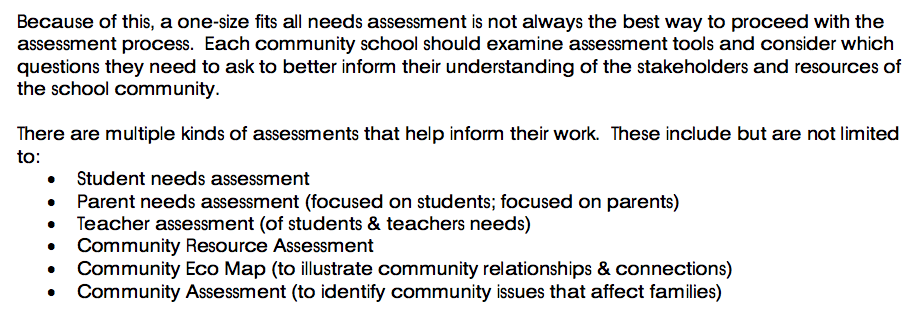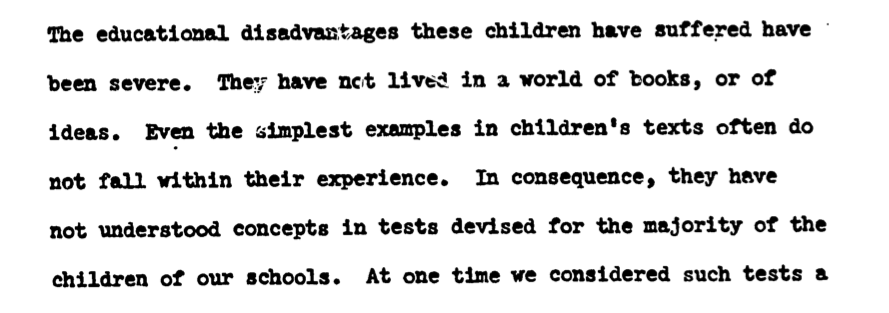“Judge schools by the extent to which they satisfactorily meet the needs of all pupils…” Cooperative Study of Secondary School Standards (1939)
Looking at an array of “indicators” helps avoid the pitfall, as seen by the School Standards study, of using testing as “a sole method of accreditation or for similar widespread comparison” because testing tends to make “instruction point definitely to success in examinations,” cultivates “a uniformity that is deadening to instruction,” can “thwart the initiative of instructors,” and can “destroy the flexibility and individuality of an institution.”
Assessing our schools has a long history of research behind it. The Cooperative Study of Secondary School Standards laid out in great detail their methodology and the tools they used to evaluate the quality of schools. They concluded there are six elements within the school that should be used to judge quality of the learning experience: 1) Curriculum, 2) Pupil activities, 3) Library, 4) Guidance, 5) Instruction, and 6) Outcomes.

Accreditation in the United States http://education.stateuniversity.com/pages/1731/Accreditation-in-United-States.html
The school improvement process that was the focus of the original study was based on:
- what the characteristics of a good school are,
- how you evaluate schools effectiveness in relation to its objectives,
- how a good school becomes better, and
- how to stimulate schools to continue to strive to become better.
The process is nothing new and it is being taught in some public institutions. An accreditation certification program at the University of California, Riverside (UCR) Extension System is one example. If you take a moment to glance through the list of topics covered, you’ll find it includes a multitude of ways to assess quality on everything from disaggregation of student data to analyzing community profiles.
To sustain an improvement process takes knowledgeable leadership. If we were serious about improving our public schools, we would quit handing over leadership training to private non-profits like the Broad Foundation’s Leadership Academy or Marc Tucker‘s “National” Institute for School Leadership. We would set standards for leadership training that included the best practices of school improvement processes. We would put quality control back in the public realm. We have no idea what these private philanthropic endeavors are teaching, but the country’s education system certainly is suffering under their leadership especially in the large urban school districts that they have taken over (last full paragraph is telling).
So to meet students’ needs a school improvement process must begin with a “needs assessment.” Various survey tools exist. We don’t need to reinvent any wheels to move forward.
Approximately 30 years after the Cooperative Study of Secondary School Standards, Effective Schools Research began to emerge. It gives us another framework by which we can approach school improvement. The Effective Schools Correlates are:
1) The principal’s leadership and attention to the quality of instruction;
2) A pervasive and broadly understood instructional focus;
3) An orderly, safe climate conducive to teaching and learning;
4) Teacher behaviors that convey the expectation that all students are expected to obtain at least minimal mastery; and
5) The use of measures of pupil achievement as the basis for program evaluation.
Approximately 30 more years passed and we now have Robert Marzano’s indicator framework developed around the Effective Schools Correlates with a bit more of a standards-aligned (standards-referenced) twist to the indicator system. The system is arranged in “levels” but should be worked on simultaneously.
Level 1: A Safe and Orderly Environment That Supports Cooperation and Collaboration
Level 2: An Instructional Framework That Develops and Maintains Effective Instruction in Every Classroom
Level 3: A Guaranteed and Viable Curriculum Focused on Enhancing Student Learning
Level 4: A Standards-Referenced System of Reporting Student Progress
Level 5: A Competency-Based System That Ensures Student Mastery of Content
If you glance through the system of indicators, you’ll find that many of the “assessments” are simple low-cost surveys. But keep in mind; school evaluations need to be tailored to the schools needs. No one-size –fits-all mandate will suffice. “Stakeholder” participation in planning makes success more likely.
And as we know, schools don’t improve and then just stay that way. Students, parents, teachers, and leaders come and go; things change. Schools must see improvement as a continuous process, always striving to be better.
But, we do need oversight. So another “accountability” piece, that goes by various names (Quality Review, Inspection, Success, or Support Teams), is teams of “outside” evaluators. The long-standing recommendation is that a visit every five years is sufficient. If schools are having difficulties, more frequent visits are recommended.
These review teams could be established within state’s departments of education (once leaders are trained in sufficient numbers). State inspections could encompass such things as assessment of the curriculum assuring that it is broad and engaging, appraisal of teachers’ continuing education ensuring quality and sufficient learning opportunities are being offered, evaluation of the level of parental and family engagement opportunities and communications, and that there is satisfactory evidence that the school is conscientiously working towards improving rather than just complying with paperwork.
Summary of Accountability Measures for Ensuring School Quality include,
- An assessment of school needs (students, teachers, partners),
- Establishment of indicators for improvement based on the needs assessment,
- Continuous self-assessments of schools and classrooms,
- Monitoring of student progress,
- Monitoring of school progress based on the school’s indicators of quality, and
- Evaluations by a Quality Review Team every 5 years or 1-2 years if needed.
“Common sense dictates that in order for students to achieve they must have appropriate opportunities to learn.” Wendy Schwartz – Opportunity To Learn Standards
Opportunity to Learn (OTL) Assessments are “a range of measurable indicators that covered both classroom experience and the overall school environment.”… “The National Council on Education Standards and Testing (NCEST, 1992) asserted that OTL standards are necessary to help close the achievement gap between advantaged and disadvantaged students.”
We have ignored establishing opportunity-to-learn standards but I believe they are incorporated into a school accountability system such as what is described here.
Currently, there are multiple versions of these ideas. I have read at least eight “new” plans from eight different organizations. Terminology varies but the major ideas remain the same. What we do know with certainty is….
“…accountability should be geared towards continuous improvement.”
—Joseph Bishop, Opportunity to Learn Campaign

















